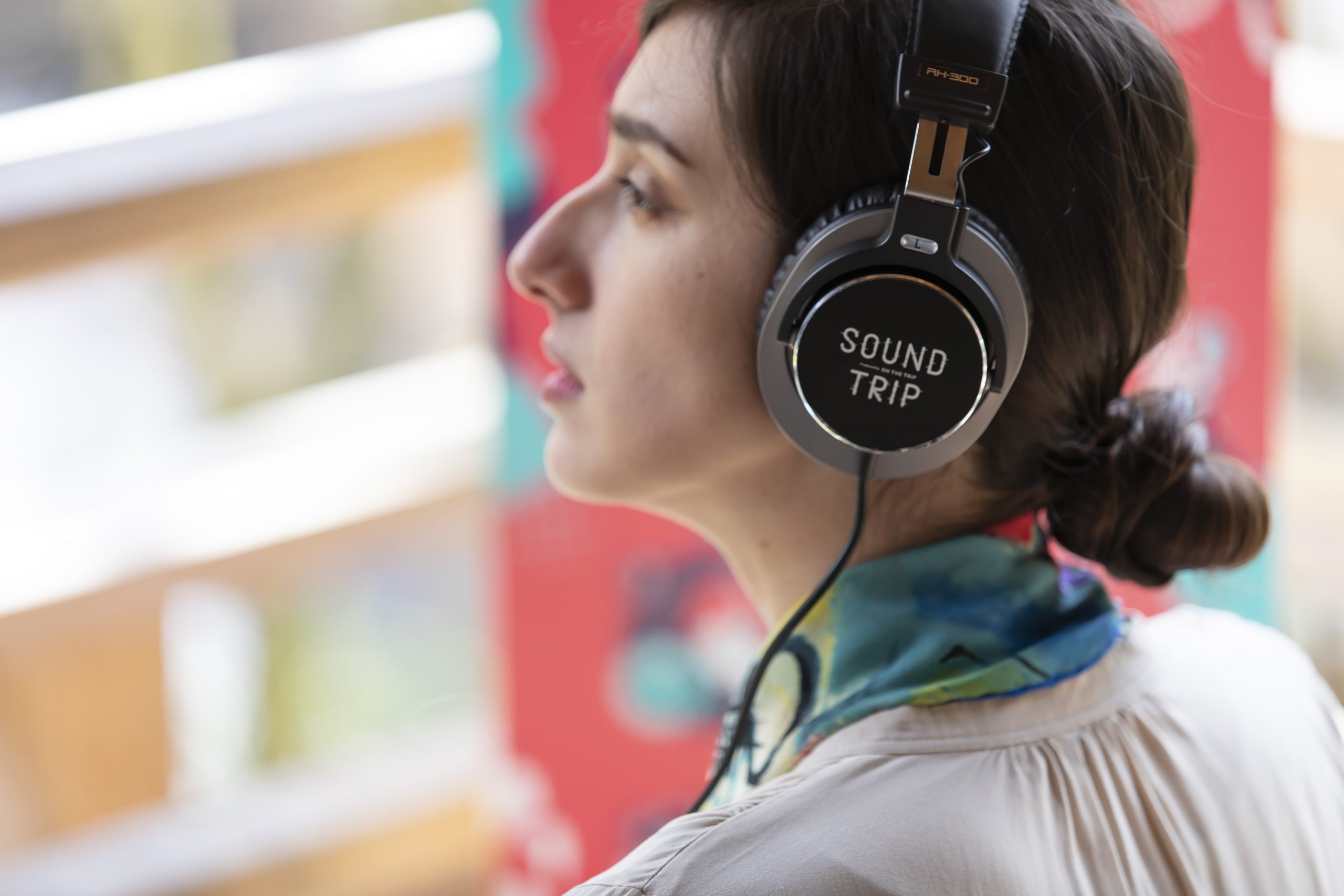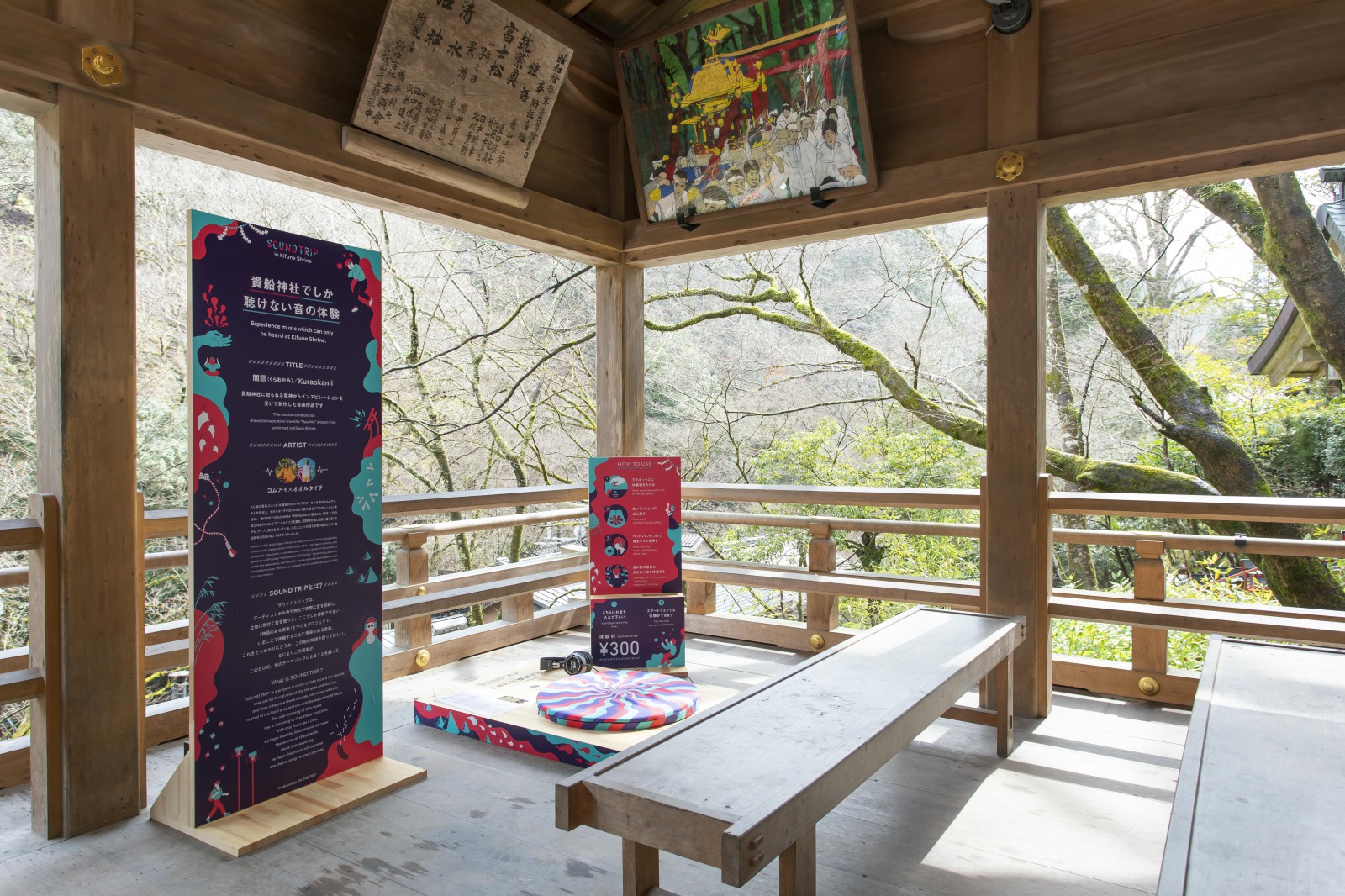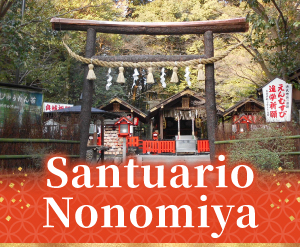
Una banda sonora para una peregrinación de tu alma en tres actos
La capital milenaria, Kioto, una ciudad antigua gobernada por una multitud de dioses donde innumerables budas han legado enseñanzas, sus ricas narraciones tejidas a partir de infinitos hilos de elegantes rollos de imágenes aristocráticas, el ascenso y la caída de los samuráis y las humildes oraciones de los habitantes del pueblo.
Estas narrativas se han desarrollado en los escenarios de los templos y santuarios de Kioto, y ahora SOUND TRIP se despliega en algunos de los más famosos: el templo Sanzen-in, el templo Mibu-dera y el santuario Kifune-jinja. Cuando visites cualquiera de estos tres lugares, siéntate en una cabina especialmente habilitada, ponte los auriculares y aíslate del mundo que te rodea. Presta atención al sonido que te invade. Te sientes mareado y poco a poco tus sentidos se difuminan. La realidad se funde lentamente con las imágenes y los recuerdos almacenados en tu interior, y comienzas a escuchar la música con el ojo de tu mente. ¿Podría ser esto algún tipo de iluminación? ¿Podría ese sonido que escuchas a través de los auriculares, resonando tan suavemente en lo profundo de tu ser, ser tu propia voz? SOUND TRIP trata sobre crear música con una historia. Estás en una peregrinación hacia tu alma, y esta es la banda sonora.
Cómo utilizar SOUND TRIP
- Siéntese en la cabina especial SOUND TRIP en un templo o santuario participante.
- Deje una donación en la caja designada (300 yenes)
- Ponte los auriculares y pulsa play
- Viaja con el sonido y el paisaje que tienes delante
【Acto Tres】Santuario Kifune-jinja
Un dragón que ascendió al cielo y un barco que navegó tierra arriba —Lluvia y tierra: fuentes de agua sagradas conectadas por dos dioses

Un mito de un barco que navega río arriba en busca de agua
El Santuario Kifune-jinja se encuentra enclavado en las montañas del norte de Kioto. ¿Por qué un santuario en las montañas recibe el nombre de un barco (Kifune significa literalmente "barco noble")? Según la leyenda, Tamayorihime, madre del primer emperador de Japón, el emperador Jinmu, navegó en un barco amarillo desde Naniwatsu (actual bahía de Osaka) río arriba por los ríos Yodo-gawa y Kamo-gawa en busca de una fuente de lluvia para el país. Mandó construir un pequeño santuario en honor a un dios del agua en el nacimiento del río. El templo recibió el nombre de Kifune en honor a este viaje.

Una de las deidades consagradas del Santuario Kifune-jinja es Takaokaminokami, el dios del agua. Takaokaminokami está estrechamente vinculado a la fe Ryujin, una creencia asociada con la lluvia y los rituales agrícolas. No es de extrañar, pues, que numerosas historias y leyendas relacionadas con el agua rodeen este lugar sagrado.
El ruido de la ciudad no llega a esta aislada aldea montañosa, por lo que el sonido de las aguas cristalinas del río Kibune-gawa se escucha por todas partes. Aquí se siente una feliz liberación al liberar los oídos. Ver y hablar te lleva a un punto de escucha. Aquí es donde nace un río, y con él este acto de tu VIAJE SONoro.
Información sobre el santuario Kifune-jinja
No se sabe con certeza cuándo se fundó el Santuario Kifune-jinja, pero hay constancia de su reconstrucción ya en el año 666. Una atracción popular son los mizuura mikuji: simples hojas blancas de adivinación en las que aparece la fortuna al depositarse en el manantial sagrado del santuario. El Santuario Kifune-jinja también se asocia con un dios del matrimonio debido a la historia de la antigua poeta Izumi Shikibu, que lo visitó para intentar recuperar el amor de su esposo.
Dirección: 180 Kuramakibune-cho, Sakyo Ward, Kioto
Horario: El recinto está abierto de 6:00 a 20:00. La oficina está abierta de 9:00 a 17:00.
Precio de la entrada: gratuita
Consultas: 075-741-2016
Sitio web oficial del santuario Kifune-jinja (japonés)
Guía turística oficial de Kioto: Santuario Kifune-jinja
Chugaeri de KOM_I y Oorutaichi
Música que solo se puede escuchar en el Santuario Kifune-jinja

El Santuario Kifune-jinja consagra a la legendaria pareja de dragones Takaokaminokami en el Hongu (sala principal) y a Yamiokaminokami en el Okunomiya (el sitio del santuario original). Takaokaminokami envía lluvia desde arriba y Yamiokaminokami supervisa el manantial subterráneo. Juntos, esta pareja de deidades se considera el mismo dios del agua. Chugaeri es un viaje auditivo alrededor del sonido capturado con un micrófono colgando en la "guarida del dragón", donde se dice que habita Yamiokaminokami.

Siéntese en la cabina al final del sendero de entrada. Mientras contempla las aguas del río Kibune-gawa y los árboles del monte Kibune-yama con sus raíces y ramas cargadas de agua, preste atención al sonido que fluye como el agua divina que brota de las profundidades del suelo sagrado.
Lo que escuchas podría ser sólo el rugido del dúo de dragones.

Un detalle más sobre el Santuario Kifune-jinja: Kifune también puede escribirse con caracteres que literalmente significan "raíz de donde nace el espíritu". En otras palabras, el agua de donde nace toda la energía y la tierra que la sustenta. Aquí, sin duda, percibirás el poder espiritual de esta palabra.


Artista: KOM_I (Wednesday Campanella) y Oorutaichi

KOM_I, vocalista del trío Wednesday Campanella, y Oorutaichi comenzaron su colaboración en 2019 con el lanzamiento del EP Yakushima Treasure. Ambos artistas están de gira con el EP bajo el nombre de Yakushima Treasure, incorporando cada vez más espontaneidad y experimentación en sus composiciones e interpretaciones. El concierto de SOUND TRIP en el Santuario Kifune-jinja es un nuevo proyecto para ambos.
Viaje sonoro 【Acto uno】Templo Sanzen-inViaje sonoro 【Acto dos】Templo Mibudera











